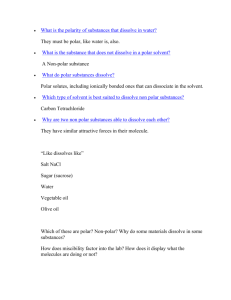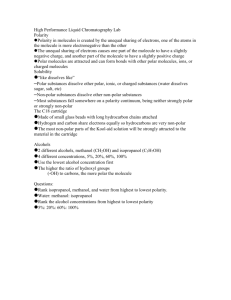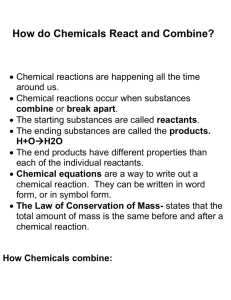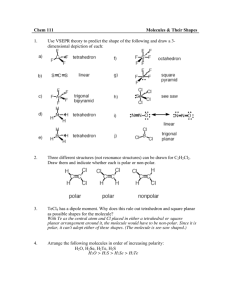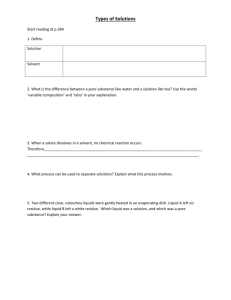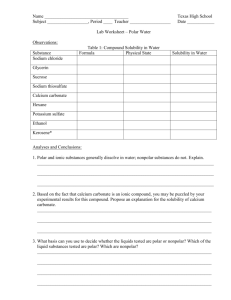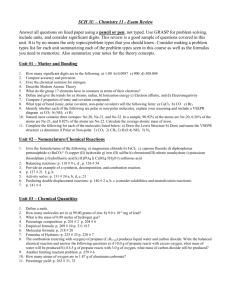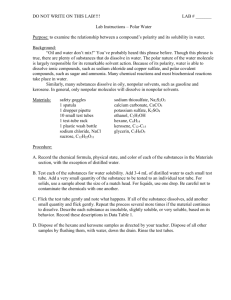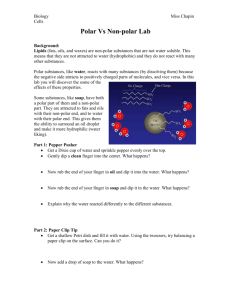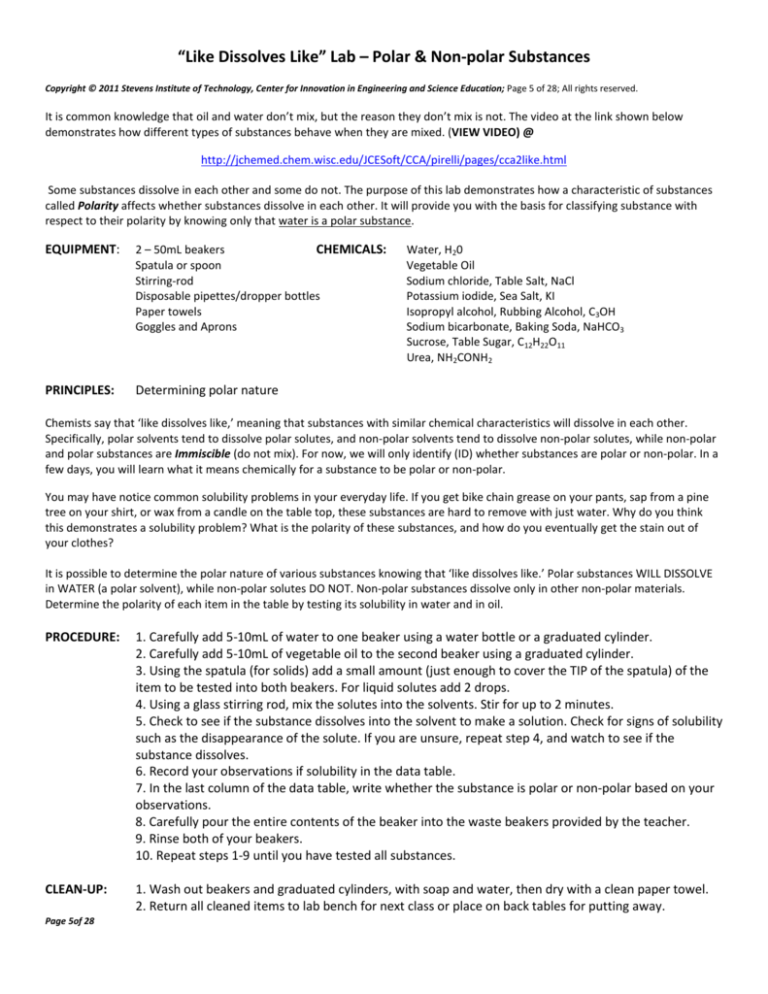
“Like Dissolves Like” Lab – Polar & Non-polar Substances
Copyright © 2011 Stevens Institute of Technology, Center for Innovation in Engineering and Science Education; Page 5 of 28; All rights reserved.
It is common knowledge that oil and water don’t mix, but the reason they don’t mix is not. The video at the link shown below
demonstrates how different types of substances behave when they are mixed. (VIEW VIDEO) @
http://jchemed.chem.wisc.edu/JCESoft/CCA/pirelli/pages/cca2like.html
Some substances dissolve in each other and some do not. The purpose of this lab demonstrates how a characteristic of substances
called Polarity affects whether substances dissolve in each other. It will provide you with the basis for classifying substance with
respect to their polarity by knowing only that water is a polar substance.
EQUIPMENT:
2 – 50mL beakers
CHEMICALS:
Spatula or spoon
Stirring-rod
Disposable pipettes/dropper bottles
Paper towels
Goggles and Aprons
PRINCIPLES:
Determining polar nature
Water, H20
Vegetable Oil
Sodium chloride, Table Salt, NaCl
Potassium iodide, Sea Salt, KI
Isopropyl alcohol, Rubbing Alcohol, C3OH
Sodium bicarbonate, Baking Soda, NaHCO3
Sucrose, Table Sugar, C12H22O11
Urea, NH2CONH2
Chemists say that ‘like dissolves like,’ meaning that substances with similar chemical characteristics will dissolve in each other.
Specifically, polar solvents tend to dissolve polar solutes, and non-polar solvents tend to dissolve non-polar solutes, while non-polar
and polar substances are Immiscible (do not mix). For now, we will only identify (ID) whether substances are polar or non-polar. In a
few days, you will learn what it means chemically for a substance to be polar or non-polar.
You may have notice common solubility problems in your everyday life. If you get bike chain grease on your pants, sap from a pine
tree on your shirt, or wax from a candle on the table top, these substances are hard to remove with just water. Why do you think
this demonstrates a solubility problem? What is the polarity of these substances, and how do you eventually get the stain out of
your clothes?
It is possible to determine the polar nature of various substances knowing that ‘like dissolves like.’ Polar substances WILL DISSOLVE
in WATER (a polar solvent), while non-polar solutes DO NOT. Non-polar substances dissolve only in other non-polar materials.
Determine the polarity of each item in the table by testing its solubility in water and in oil.
PROCEDURE:
1. Carefully add 5-10mL of water to one beaker using a water bottle or a graduated cylinder.
2. Carefully add 5-10mL of vegetable oil to the second beaker using a graduated cylinder.
3. Using the spatula (for solids) add a small amount (just enough to cover the TIP of the spatula) of the
item to be tested into both beakers. For liquid solutes add 2 drops.
4. Using a glass stirring rod, mix the solutes into the solvents. Stir for up to 2 minutes.
5. Check to see if the substance dissolves into the solvent to make a solution. Check for signs of solubility
such as the disappearance of the solute. If you are unsure, repeat step 4, and watch to see if the
substance dissolves.
6. Record your observations if solubility in the data table.
7. In the last column of the data table, write whether the substance is polar or non-polar based on your
observations.
8. Carefully pour the entire contents of the beaker into the waste beakers provided by the teacher.
9. Rinse both of your beakers.
10. Repeat steps 1-9 until you have tested all substances.
CLEAN-UP:
1. Wash out beakers and graduated cylinders, with soap and water, then dry with a clean paper towel.
2. Return all cleaned items to lab bench for next class or place on back tables for putting away.
Page 5of 28
Chemistry: Finding Solutions
Name
Group
Copyright © 2011 Stevens Institute of Technology, Center for Innovation in Engineering and Science Education; Page 6 of 28; All rights reserved.
DATA TABLE – Polar or Non-Polar?
SOLUTE
NaCl
KI
CH3OH
NaHCO3
C12H22O11
NH2CONH2
OIL
DISSOLVES in H2O?
“Like Dissolves Like” LAB
DISSOLVES in OIL?
POLAR or
NON_POLAR?
CONCLUSION QUESTIONS:
1. For centuries, sailors used tree sap (pitch) to seal the spaces between the planks on wooden boats.
EXPLAIN why pitch worked well as a sealant in this situation.
2. In order to reduce the expose to organic solvents like turpentine, some art instructors recommend
the students clean brushes and hands with vegetable oil or mineral oil. Would such oils be more
effective removing water-based paints or oil-based paints? EXPLAIN.
3. Coffee, tea, and soft-drink stains are generally removed in the wash, while stains from candle wax,
salad dressing, and peanut butter require special treatment. EXPLAIN why.
4. EXPLAIN why oil can’t blend/mix with water using the analogy of people holding hands to illustrate.
5. Based upon your lab, EXPLAIN the phrase “like dissolves like.”
Hydrogel Design Question-From what you have learned in this lab activity can you say why your manager
selected sodium alginate as the starting polymer for the hydrogel?
Copyright © 2011 Stevens Institute of Technology, Center for Innovation in Engineering and Science Education; Page 7 of 28; All rights reserved.
Page 8 of 28
BLANK

